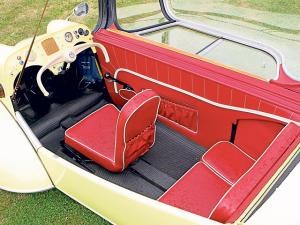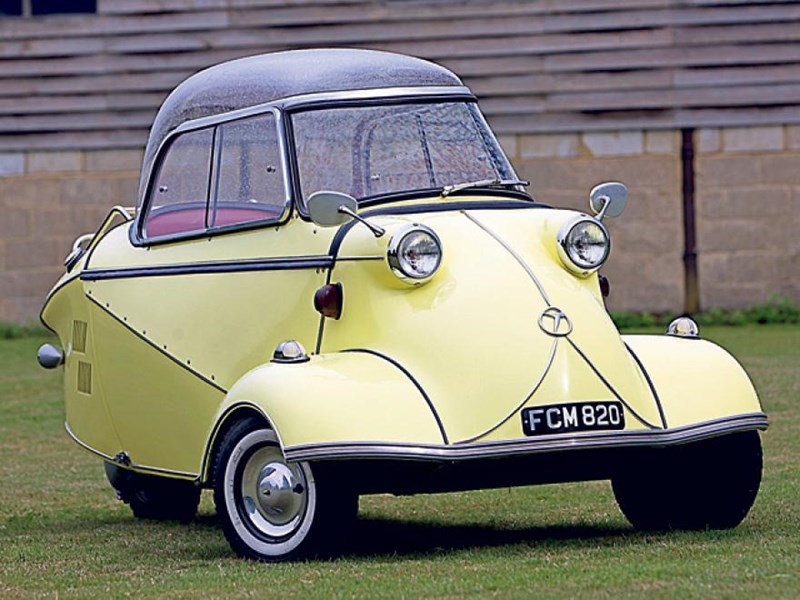Designed by Mr Fend, an aircraft engineer from south west Germany, the otherwise redundant workforce at the Messersschmitt aircraft company were much relieved to be manufacturing the KR-175 microcar, introduced from 1953, with production lasting until 1955 when the new KR-200 came in. ''Motor car comfort at microcar costs!'' was the slogan for the new KR-200 which featured revised bodywork, a new panoramic windscreen and conventional floor mounted accelerator and clutch operation. Retaining the tandem seating, but introducing new handlebar controls from the old twist grip operation, the new model also featured an electric starter and electrically operated reverse gear, while double dip twin headlamps and flashing indicators improved the facilities for the driver. When driven carefully, these models could achieve 80mpg. Performance was improved from the old Sachs 175cc 9hp single cylinder model, capable of 55mph, to the new 191cc KR-200 version which boasted a top speed of 62mph.
AT THE WHEEL
Although not derived from surplus aviation parts as legend suggests, there’s more than a little aircraft in the Messerschmitt’s design. Access to the cabin is from the side-hinged plexiglass dome – even open-topped versions were accessed by swinging open the upper panels. With occupants entwined in tandem fashion, the two-stroke fun can begin.
There’s none of the steering wheel nonsense you find in other vehicles; instead, handlebars control the high-geared steering, with only three-quarters of a turn from lock-to-lock. The twist-grip throttle control of the KR175 – which doesn’t always self-return – was abandoned for the KR200’s conventional pedal. Softer suspension is a welcome addition to later models. With very little weight to lug around, the one-cylinder engine gives lively performance, even if cross-winds make dual carriageways a challenge.
The additional rear-based weight of the ‘Tiger’ is noticeable, but so is the extra power from its 493cc twin. Even without a reduced wheel count, the three-wheeled Messerschmitts were not only remarkably stable, but surprisingly usable.
WHY YOU WANT ONE
You have to be a bit of an individual to drive a Messerschmitt. Back in the early 1950s, the German-built three-wheeler was simply a cheap mode of transport. ‘Kabinenroller’ literally meant ‘enclosed scooter’. As a result, the ’Schmitt is a far more usable city tool than its aeroplane-without-wings appearance belies. It’s nippy, economical (easily topping 60mpg), and guaranteed to draw a crowd.
The KR175, born in 1953, was the offspring of engineer Fritz Fend and production-hungry aircraft builders Messerschmitt. The ‘Kabinenroller’ saloon was unlike anything that had taken to the roads before. A 173cc two-stroke engine churned out a mighty 9bhp. Within two years, the much-improved KR200 had replaced it, boasting 10.2bhp from 191ccs, plus convertible and KR201 roadster iants.
Real performance came courtesy of the Tg500. Nicknamed the ‘Tiger’, only 450 examples of this four-wheeled iant were built – far less than the 60,000 plus three-wheelers. However, 19.5bhp and a staggering 78mph top speed knocked the lesser ’Schmitts into a cocked hat.
VITAL STATISTICS
Messerschmitt KR200Messerschmitt TG500 ‘Tiger’
Engine191cc/1-cyl/2-stroke493cc/2-cyl/2-stroke
Power10.2bhp@5250rpm20bhp@5000rpm
Torque11lb ft@3800rpm24.6lb ft@4000rpm
Top Speed62mph78mph
0-60mphA very long time27.8sec
Economy75mpg43.8mpg
Gearbox4-speed manual (no reverse)4-speed manual
WHAT TO LOOK FOR
1 The KR175 had its steel panels welded onto a steel chassis, while the later KR200 used a steel monocoque. As a result, rust is a major concern. "Two-thirds of Messerschmitts in the UK will probably have been re-panelled," reckons Alan Hitchcock of specialists Alan’s Bubble Cars. As a result, examples with good, original bodywork will always command a premium.
Check the corners where the front wings meet the passenger compartment – the door-opening side collects water and rusts first. Floorpans decay around the edges, while the bottom edges of the door panel are notoriously difficult to repair correctly. The rear ‘boot’ panel can suffer from fatigue where the optional luggage rack mounts, and rust can also attack its edges.
Fortunately, the glass windscreen and the plexiglass bubble dome are available new – still being produced from the original moulds.
2 Two-stroke power came courtesy of a 173cc Fitchel & Sachs single-cylinder engine for the KR175, while an enlarged 191cc unit propelled the later models.
The ‘Tiger’ used a vertical twin-cylinder 493cc unit, designed by Fitchel & Sachs but built in-house. "They’re very good engines, but they have to work hard," explains Alan. As a result, 20,000-25,000 miles between rebores is quite normal. Severe howling from the engine at speed suggests excessive wear. Oil seals need to be in tip-top condition to ensure long life. Although simple in design, experience is required to correctly set up these engines. "A badly set-up engine will work, but not work well," says Alan.
3 Gearboxes always had four forward speeds, with no synchromesh. Reverse gear was never built into the unit, although an optional transfer box provided this function on the KR175. No such option was offered on the KR200. Instead, the engine could be switched off and then restarted to run backwards – potentially giving four reverse gears. A conventional reverse gear was fitted to the ‘Tiger,’ along with a final drive and driveshafts in place of the three-wheelers’ chain drive. Remove the clutch inspection hatch and carefully lift the clutch basket up and down.
A remanufactured clutch bearing will give more play than an original, but excessive slop means a replacement bearing is needed.
4 Rubber is used to soak up the bumps, with the stiff rubber mounts of the KR175 replaced by torsional rubber bushes and hydraulic dampers on later models. The rubber has to be in good condition in order to work at peak performance.
The ‘Tiger’ boasted chunkier 10" wheels, with coil springs over lower wishbones at the rear providing independent springing. This bulkier set-up puts a lot more weight over the rear wheels, so check for play in any of the joints.
5 Cable-operated drums were fitted to the three-wheelers, while the ‘Tiger’ used a hydraulic system. "The KR200 brakes are merely adequate," says Alan. Frequent servicing is required to keep them in good form – it would be worth asking the seller if this has been done on a regular basis. Offering much less power, the KR175 puts far less strain on its stoppers.
Tyre choice can cause problems. Many owners use trailer-spec tyres, which aren’t designed for ’Schmitts, As a result, correctly functioning brakes can easily lock up the wheels.
VERDICT
On today’s overcrowded roads, a ’Schmitt can give a great deal of pleasure. Whether you favour its go-kart driving experience, the fashionable out-of-this-world styling, or even its turbo diesel-rivalling economy, you’d have to be pretty mean-spirited not to be charmed by these tiny cars.
As a result of the high regard in which they are held – not to mention their relatively low numbers – the Messerschmitts are not bargains. Poor three-wheeler ‘Kabinenrollers’ command more than £3000, while the very best ‘Tiger’ could easily break the bank at a phenomenal £45,000.
If you can afford to take the plunge, however, you won’t regret it. As a delightful and enjoyable slice of motoring history, a good Messerschmitt is hard to beat.

